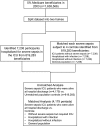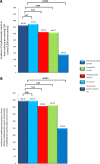Risk of cardiovascular events in survivors of severe sepsis
- PMID: 24456535
- PMCID: PMC4098105
- DOI: 10.1164/rccm.201307-1321OC
Risk of cardiovascular events in survivors of severe sepsis
Abstract
Rationale: The risk of cardiovascular events after severe sepsis is not known, and these events may explain increased long-term mortality in survivors of severe sepsis.
Objectives: To determine whether survivors of severe sepsis hospitalization have high long-term risk of cardiovascular events. We examined whether higher risk is due to severe sepsis hospitalization or poor prehospitalization health status, and if the higher risk is also observed in patients hospitalized for infectious and noninfectious reasons, and in other critically ill patients.
Methods: Unmatched and matched-cohort analyses of Medicare beneficiaries. For unmatched analysis, we compared patients with severe sepsis admitted to the intensive care unit (ICU) and survived hospitalization (n = 4,179) to unmatched population control subjects (n = 819,283). For matched analysis, we propensity-score-matched each patient with severe sepsis to four control subjects (population, hospitalized, non-severe sepsis ICU control subjects, and infection hospitalization). Primary outcome was 1-year incidence rate of hospitalization for cardiovascular events.
Measurements and main results: Cardiovascular events were common among patients discharged alive after severe sepsis hospitalization (29.5%; 498.2 events/1,000 person-years). Survivors of severe sepsis had a 13-fold higher risk of cardiovascular events compared with unmatched control subjects (498.2 vs. 36 events/1,000 person-years; P < 0.0001), and a 1.9-fold higher risk compared with matched-population control subjects (P < 0.0001). Survivors of severe sepsis had 1.1-fold higher risk compared with matched hospitalized patients and infection hospitalizations (P = 0.002 and 0.001) and similar risk compared with matched-ICU control subjects.
Conclusions: Survivors of severe sepsis have high risk of cardiovascular events. The higher risk is mainly due to poor prehospitalization health status, and is also seen in a broader population of acutely ill patients.
Figures




References
-
- Angus DC, Linde-Zwirble WT, Lidicker J, Clermont G, Carcillo J, Pinsky MR. Epidemiology of severe sepsis in the United States: analysis of incidence, outcome, and associated costs of care. Crit Care Med. 2001;29:1303–1310. - PubMed
-
- Alberti C, Brun-Buisson C, Burchardi H, Martin C, Goodman S, Artigas A, Sicignano A, Palazzo M, Moreno R, Boulmé R, et al. Epidemiology of sepsis and infection in ICU patients from an international multicentre cohort study. Intensive Care Med. 2002;28:108–121. - PubMed
-
- Winters BD, Eberlein M, Leung J, Needham DM, Pronovost PJ, Sevransky JE. Long-term mortality and quality of life in sepsis: a systematic review. Crit Care Med. 2010;38:1276–1283. - PubMed
-
- Wunsch H, Guerra C, Barnato AE, Angus DC, Li G, Linde-Zwirble WT. Three-year outcomes for Medicare beneficiaries who survive intensive care. JAMA. 2010;303:849–856. - PubMed
Publication types
MeSH terms
Grants and funding
LinkOut - more resources
Full Text Sources
Other Literature Sources
Medical

